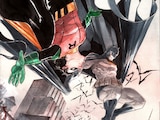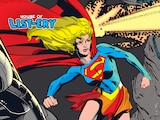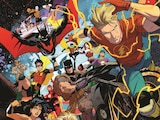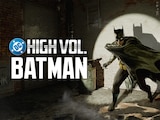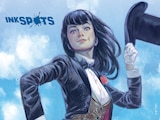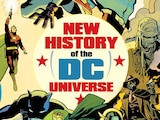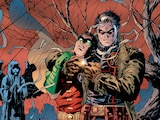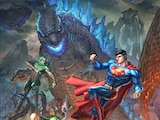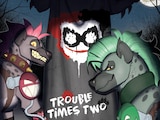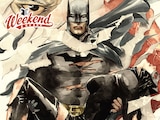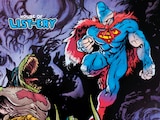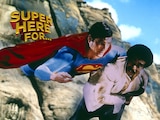All this month, we’ve been celebrating the life and legacy of George Pérez, one of the greatest artistic architects of the DC Universe as we know it today. Without Pérez’s influence, we wouldn’t have the majesty and grandeur of Crisis on Infinite Earths, we wouldn’t have the definitive incarnation of the Teen Titans, and Wonder Woman would be unrecognizable. But as important as those series are to the grand DC mythology, George Pérez contributed his remarkable artistry much wider in the time we shared with him. Pérez may no longer be with us, but his work in comics ensures that his legacy will live on as long as we keep believing in heroes. For those of you who, like us, are looking for any excuse to spend just one more afternoon with one of our greatest artists, we’re pleased to direct you to some of Pérez’s hidden gems in his vast art collection.

Justice League of America #184-186, 192-197, 200
At the same time that he was redefining the Teen Titans with Marv Wolfman, George Pérez was creating some of the most dramatic Justice League stories since the Silver Age with writer Gerry Conway.
Just as he was beginning his career with DC in 1980, Pérez was showing us just what he was capable of with a grand, multiverse-spanning battle of the Justice League of Earth-One, Justice Society of Earth-Two and New Gods of New Genesis against the resurrected threat of Darkseid. And that was just the opening course. To follow, Pérez illustrated the origin of Red Tornado, the birth of the Secret Society of Super-Villains, and united Earth’s greatest heroes against the first supervillain in comics: Ultra-Humanite. It was an exciting period for the League, representing some of the highest stakes adventures they had together before disbanding to make way for the Detroit team—and then Crisis on Infinite Earths. In these ten issues, the Pre-Crisis Justice League never stood as tall as they did under Pérez’s pencils.

DC Comics Presents #61
One of Jack Kirby’s most unique creations for DC was OMAC: The One Man Army Corps, the symbol of a dystopian “world that’s coming” meant as a grim warning of our own future to come. But while OMAC would wind his way through fringe titles like Mike Grell’s Warlord and Kirby’s own Kamandi, OMAC’s first encounter with the DC Universe at large came courtesy of George Pérez and Len Wein in the Superman team-up book DC Comics Presents.
In this adventure, OMAC joins forces with Superman to defeat a robot assassin from the future. The “MurderMek’s” mission: assassinate the 20th century ancestor of OMAC’s human host to erase him from the timeline. Apropos of nothing, we’d just like to note here that the film The Terminator wasn’t released until the following year.

History of the DC Universe
As grand as Pérez and Wolfman’s partnership on Crisis on Infinite Earths was, the two-volume series which followed it was perhaps even more grandiose. Where Crisis endeavored to present every corner of the DC Universe at a single, phenomenal point, The History of the DC Universe presented the entire remade reality in chronological order, from the beginning of the universe to the distant future of the Legion of Super-Heroes.
Every period of DC history is lavishly presented by Pérez in stunning reliefs as backdrop against Wolfman’s narration, coalescing as one cohesive vision of DC’s world of heroes the likes of which had never been seen before. Pérez’s dazzling art and Wolfman’s prosaic recounting of a new DC history would do much of the work to reset the table in the Post-Crisis age. Years later, Pérez and Wolfman’s work on this historic text would inspire one of DC Black Label’s best series, The Other History of the DC Universe.

Who’s Who
As History of the DC Universe presented a chronological account of the new Post-Crisis Earth, the simultaneous Who’s Who series provided an accounting of its dramatis personae—detailed biographies of every significant DC character to that date. The elaborate detail in the biographies for favorite and soon-to-be-favorite characters was only half the appeal, though. Each entry included just as elaborate illustrations which encapsulated the essence of the character profiled, all drawn by the greatest working comic artists of the era.
Of course, that meant Pérez was all over the series. In fact, some of his best work was on the Who’s Who covers, which combined all the characters profiled in each issue into one compelling group shot. But his interior work which accompanied many of the profiles within was a treat for any reader.

Action Comics #643-652
It wasn’t too long into the Post-Crisis era that a refreshed Superman was already undergoing an identity crisis. After a self-imposed exile following a traumatic visit to an apocalyptic pocket dimension, it was time to bring back Superman’s optimism. So, who better to see it happen than the man who had just revitalized Wonder Woman?
For ten issues of Superman’s debut series, Pérez gets Superman better acquainted with a new Supergirl, conjures up a vile confederacy of Brainiac and Metallo, and introduces a new character into Superman’s life: Maxima, queen of the planet Almerac who seeks the Man of Steel as her perfect mate.

The Brave and the Bold #1-10
Mark Waid’s 2008 reboot of The Brave and the Bold was a concept worthy of its title. What if, instead of a Batman-focused team-up book, The Brave and the Bold could tell the story of any variety of heroes teaming up at any time? The result was some of the most interesting character dynamics you’d never get the chance to see in any other comic. And when it came to the art, only one man could be up for the job—the man who had more experience drawing the heroes of the DC Universe together than anyone else, George Pérez.
DC’s most lore-knowledgeable writer and the man who’s drawn more DC characters together than anyone else? Now that’s what we call a team-up.

Final Crisis: Legion of Three Worlds
George Pérez spent decades building a reputation as the master of crowd shots, for when you really needed to populate the DC Universe with a wealth of life and personality. But even for an artist who drew all of Crisis on Infinite Earths, Final Crisis: Legion of Three Worlds was a unique challenge: a story which brought together three different Legions of Super-Heroes from three different continuities into one grand event.
Juggling the massive rosters of each of these teams with frequently overlapping identities and personae with wildly different histories is as daunting a task as any artist could be asked to handle. But in his union of every version of every Legionnaire, Pérez proved once and for all that there was no task too large for his talent. George Pérez would retire from comics only a few years after this series, but you wouldn’t be wrong to say that Legion of Three Worlds was Pérez showing the kids on his way out exactly how this comic book business is done.
With Legion, Pérez proved once and for all that through his thirty years with DC, nobody could do it quite like him. And in his wake, future artists can do no better than to study his example, at the feet of this New Titan.
Alex Jaffe is the author of our monthly "Ask the Question" column and writes about TV, movies, comics and superhero history for DCComics.com. Follow him on Twitter at @AlexJaffe and find him in the DC Community as HubCityQuestion.
For most, it's George Pérez's art that made so many DC readers into fans, but sometimes it's something more unexpected—like a children's video game.




